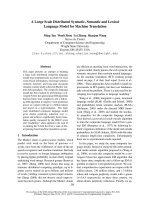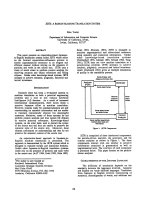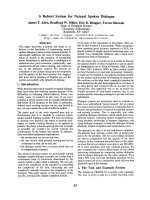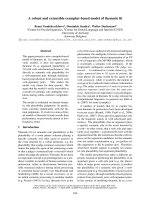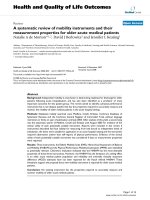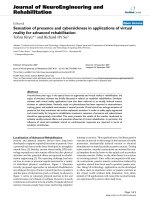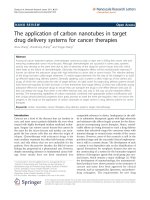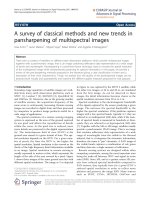Báo cáo hóa học: " A Robust on-Demand Path-Key Establishment Framework via Random Key Predistribution for Wireless Sensor " doc
Bạn đang xem bản rút gọn của tài liệu. Xem và tải ngay bản đầy đủ của tài liệu tại đây (1.01 MB, 10 trang )
Hindawi Publishing Corporation
EURASIP Journal on Wireless Communications and Networking
Volume 2006, Article ID 91304, Pages 1–10
DOI 10.1155/WCN/2006/91304
A Robust on-Demand Path-Key Establishment Framework via
Random Key Predistribution for Wireless Sensor Networks
Guanfeng Li,
1
Hui Ling,
1
Taieb Znati,
1
and Weili Wu
2
1
Department of Computer Science, University of Pittsburgh, Pittsburgh, PA 15260, USA
2
Department of Computer Science, University of Texas at Dallas, Richardson, TX 75083-0688, USA
Received 2 October 2005; Revised 11 January 2006; Accepted 12 January 2006
Secure communication is a necessity for some wireless sensor network (WSN) applications. However, the resource constraints of a
sensor render existing cryptogr aphic systems for traditional network systems impractical for a WSN. Random key predistribution
scheme has been proposed to overcome these limits. In this scheme, a ring of keys is randomly drawn from a large key pool and
assigned to a sensor. Nodes sharing common keys can communicate securely using a shared key, while a path-key is established
for those nodes that do not share any common keys. This scheme requires moderate memory and processing power, thus it is
considered suitable for WSN applications. However, since the shared key is not exclusively owned by the two end entities, the
established path-key may be revealed to other nodes just by eavesdropping. Based on the random-key predistribution scheme,
we present a framework that utilizes multiple proxies to secure the path-key establishment. Our scheme is resilient against node
capture, collusive attack, and random dropping, while only incurring a small amount of overhead. Furthermore, the scheme
ensures that, with high probability, all path-keys are exclusively known by the two end nodes involved in the communication along
the path.
Copyright © 2006 Guanfeng Li et al. This is an open access article distr ibuted under the Creative Commons Attribution License,
which permits unrestricted use, distribution, and reproduction in any medium, provided the original work is properly cited.
1. INTRODUCTION
Recent advances in wireless technologies have led to a new
generation of inexpensive sensors and actuators. Individ-
ually, these devices are resource-constrained and, as such,
are only capable of a limited amount of processing and
communication. When deployed in a large number, how-
ever, the coordinated effort of these networked devices bears
promises for a significant impact, not only on science and
engineering, but equally importantly on a broad range of
civil and military applications, including health care, crit-
ical infrastructure protection, environmental and wildlife
monitoring, crisis management, and military reconnais-
sance.
Harnessing the potential of wireless sensor networks,
however, brings about a number of fundamental challenges,
the most critical of which is security. It is frequently the case
that sensors are deeply embedded into the environment or
deployed in open areas, making them vulnerable to physical
attacks and potentially compromising sensor nodes’ security.
Secure communication among sensors, dur ing the response
phase to an attack on a critical infrastructure, for example, is
crucial for emergency responders to successfully coordinate
their activities. Malicious information, injected by attackers
during the response phase may hamper greatly the ability of
first responders to communicate and share data. Cry ptology
methods are, therefore, needed to achieve secure communi-
cation among sensor nodes.
Since sensors will either have to be powered by small
nonrenewable batteries, or by a modest amount of energy
that can be harvested from the environment, developing
energy-efficient cryptographic algorithms and methods is a
critical issue in designing security protocols for wireless sen-
sor networks. The sensors’ resource constraints, coupled with
their limited knowledge of the topology within which they
are deployed, render public-key-infrastruc ture-(PKI) based
schemes inappropriate for wireless sensor networks. Carman
et al. pointed out that asymmetric cryptography algorithms,
like 1024-bit RSA, consume at least two orders of magni-
tude more energy than symmetric cryptography algorithms,
such as 1024-bit AES in [1]. Furthermore, symmetric-key
cipher and hash functions execute between two to four or-
ders of magnitude faster than their asymmetric counterparts.
Similarly, trusted server-based cryptography systems, such as
Kerberos, do not apply in WSNs, as these schemes require a
trusted third party which is not always available in WSNs.
Consequently, these schemes may not be scalable when a
WSN involves thousands of sensor nodes. These constraints
2 EURASIP Journal on Wireless Communications and Networking
leave designers of security protocols for WSNs with no choice
but to use symmetric-key cryptographic systems.
In symmetric-key cryptographic systems, keys have to be
installed onto sensors before deployment. Nodes then use
shared keys to conduct secure communication. Two strate-
gies can be used to distribute shared keys between sensors in
WSNs. In the first strategy, all sensor nodes share the same
session key, while in the second case each sensor node shares
a unique key with each of the remaining n
− 1 sensors, where
n is the total number of sensors in the WSN. The advantage
of the first strategy stems from its low maintenance cost. In
this strategy, however, the compromise of one single node
may jeopardize the security of the entire network. The second
strategy has potential to achieve perfect security even when a
numberofnodesarecaptured.InlargeWSNs,however,this
approach requires installing n
− 1 keys in each sensor and, as
such, may be prohibitive, given the limited memory size of
a sensor node. Furthermore, sensors are likely to fail due to
hardware faults or energy depletion caused by excessive com-
munication. Consequently, in order to maintain the level of
node density required to meet the quality of service require-
ment of the applications, new sensors may have to be injected
into the existing network. The addition of these nodes fur-
ther limits the applicability of the second approach, as it re-
quires installing new keys into the existing sensors in order
to facilitate communication between these sensors and the
newly injected ones.
To overcome the shor tcomings of the above strategies, a
random key predistribution scheme has been proposed [2].
This scheme only requires a relatively small number of keys,
in the order of ten to one hundred, to be installed onto each
node, to achieve connectivity between pair of nodes with
high probability. The link with two end nodes sharing keys
is called secure link. Nodes that do not share a key set up a
path-key, through negotiation, using paths formed by secure
links. The major shortcoming of this scheme is during path-
key establishment, communication between the end nodes is
exposed to intermediate nodes along the path.
This path-key establishment problem has been intro-
ducedin[3]. Furthermore, it is shown that the risk of the
path-key being revealed can be significantly decreased by us-
ing multiple node-disjoint secure paths to establish the path-
key. However, the proposed scheme may incur too much
extra overhead due to the necessity of discovering multiple
node-disjoint paths between sources and destinations.
In this paper, we aim to set up a framework that uses mul-
tiple secure-one-hop paths instead of node-disjoint paths to
enhance the security of path-key establishment. We present
two efficient algorithms for discovering these intermediate
hops (referred as proxy). It is shown both through analy-
sis and simulation that our scheme can achieve a very high
level of security, while simultaneously reducing the over-
head.
The rest of this paper is organized as follows. Section 2
introduces related work. In Section 3,wedescribeourro-
bust key establishment framework to secure the path-key us-
ing multiple proxies. Furthermore, we show how to discover
such proxies in two algorithms. The security analysis and
simulation results show that our scheme can achieve a high
level of security. Conclusions are drawn in Section 4 .
2. RELATED WORK
The random key predistribution scheme was first introduced
by Eschenauer and Gligor [2]. Using this framework, differ -
ent methods of key generation and distribution have been
proposed to improve energy efficiency and security [4–7]. A
q-composite random key predistribution scheme has been
proposed which increases the security of key set-up in way
such that an attacker has to capture a large number of nodes
to compromise a communication, with high probability [4].
The authors also propose a multipath-key reinforcement
scheme to update an existing link key to a unique key, thereby
ensuring that the key is not used by any other sensor node.
Although the scheme proposed in this paper uses multiple
paths, it differs from the one proposed in [4] in that the pro-
posed scheme achieves the same level of security, without the
need to use node-disjoint paths. Computing node-disjoint
paths is known to be NP-hard, and, therefore, may result in
considerable communication overhead.
In the random key predistribution scheme proposed in
[5], each node only needs to carry a fraction of the keys re-
quired by [2], while achieving the same level of security. This
scheme has the potential to reduce memory usage and im-
prove the network’s resilience against node compromise. To
achieve this goa l, however, the scheme requires prior knowl-
edge of sensor deployment within the WSN, which may not
be readily available at any time. Furthermore, if the sensor
nodes are moving, the network topology changes, thereby
making prior knowledge deployment obsolete. Deployment
knowledge was also used in [8] to improve key predistribu-
tion. The authors further exploited postdeployment knowl-
edge to discard keys in a node where the keys are not shared
with the node’s actual neighbors to thwart node compromise
attacks and vacate the precious memory space to be used by
the loaded applications.
Another location-based key predistribution scheme
based on deployment knowledge is described in [9]. A distin-
guishing property of this framework from the above schemes
is that it does not require the knowledge of sensors’ expected
locations, but only requires to deploy sensor nodes in groups.
Consequently the burden to deploy each sensor in the sensor
network to the vicinity of its expected location is greatly re-
duced. However, since sensors are deployed in groups, node
addition and key revocation in existing nodes are not easy for
this network.
In [10] a seed-based key deployment strategy to discover
shared keys, in a m ore energy-efficient manner, is described.
All the keys in the key pool are indexed. Each node uses its
ID as the seed and uses a pseudorandom function to gener-
ate the key indexes. It then loads the corresponding keys onto
itself. This scheme requires more memory space as nodes
have to store the associated indexes along with the keys. The
scheme may also require additional computation, but no
communication is required for two nodes to discover if they
share a key between them.
Guanfeng Li et al. 3
The schemes described in [7] use a similar technique to
discover shared keys. Although these new schemes save com-
munication, they pose a security threat. After capturing a
node, an attacker can gain additional advantage by selectively
eavesdropping on nodes that are known to share keys with
the captured one.
To prevent this attack, the key distribution strateg y pro-
posed in this paper adopts the original scheme described in
[2]. Notice that the scheme described in [10] also sets up
path-keys using different logic paths. However, the scheme
cannot use the original shared key mechanism to discover
these logic paths.
Both [4, 6] propose a scheme to support key authentica-
tion by generating unique pairwise keys. In [4], a node loads
a set of node IDs and a unique pairwise key k is generated
for each pair of nodes. Hence, if k is used to secure com-
munication, both nodes are certain of their respective iden-
tities, since no other node pair can hold k.In[6] the random
key predistribution is combined with Blom’s key predistri-
bution scheme [4]toachieve“λ-security.” This level of se-
curity is achieved only if an adversary cannot compromise
more than λ nodes; uncompromised nodes remain perfectly
secure. When more than λ nodes are captured, the entire net-
work may be compromised if just one key space is used.
While the security of random key predistribution
schemes has made significant improvement, the path-key es-
tablishment problem has not yet been fully addressed [3]. In
this paper, we propose to improve the path-key security using
multiple secure proxies.
3. ROBUST PATH-KEY ESTABLISHMENT
We first review Gligor’s work upon which our work is based
and give an example to highlight the main idea. In his
scheme, each node is installed with a key ring of m keys ran-
domly drawn from a large key pool, P. This scheme requires
moderate memory space for storing a key ring, and therefore
can be used in a very large network. For example, if a key ring
consists of 20 keys and is drawn from 1000 keys, theoretically
it can support up to (
1000
20
) = 2.4 × 10
19
nodes, and only re-
quires 160 bytes assuming 64-bit key cryptography system.
After being deployed, two nodes within transmission range
exchange either key identifiers or challenges to discover com-
mon keys in their key rings. Then a common key is selected
for secure communication between these two nodes. Node
pairs without a common key establish a path-key through a
secure path.
In the network depicted in Figure 1, it is assumed that
shared keys have been discovered as illustrated by dashed
links. According to this example, N1 shares a key with N2
but not with N3orN4. When N1 wants to communicate
with N3, it finds a secure path N1
→ N2 → N4 → N3and
sends a key K to N3 through the established path. K is en-
crypted with K
12
, K
24
,andK
34
, respectively, as it travels from
N1toN3. Notice, however, that while the pairwise key K is
supposed to be exclusively shared between N1andN3, the
need for successive decryptions and encryptions along the
path causes the key to be exposed to the intermediate nodes
K
12
K
24
K
34
K
35
K
46
K
67
1
2
4
3
5
6
7
Physical link
Secure link
Figure 1: An example sensor network after shared key discovery.
N2andN4. This may lead to potential security compromise
if a node along the path is captured. This problem is referred
as the “path-key establishment problem” in [3].
Another security concern about this framework is that
the probability of any two nodes sharing keys is high.
In the last example, the probability is 33.5%. If the key
ring size is increased to 30, the probability will be over
60.5%. Any key in the key pool has a probability equal to
(key ring size/key pool size) to be installed on one node. In a
large WSN, if two nodes are using a shared key to talk to each
other, chances are, there will be some nodes in the neighbor-
hood that hold this shared key they are using. This situation
demands that two nodes set up a path-key for a private com-
munication even if they shared keys on their key r ings.
Using multiple node-disjoint paths to secure the path-
key establishment has been proposed to cope with the risk
that compromising one node along the path leads to reveal-
ing the path-key [3]. A path-key K is broken down into k
nuggets and sent along k node-disjoint paths. All nuggets are
required to reconstruct K. Therefore, an attacker would have
to capture at least one node along each path to obtain the
key. However, as pointed out above, these key nuggets are ex-
posed to each intermediate node along the routing path. In
summary, this scheme has the following undesirable features.
(i) It involves a high level of overhead to find node-
disjoint paths. Furthermore, in some cases, it may
not b e physically feasible to construct k node-disjoint
paths.
(ii) Contrary to intuition, increasing the number of node-
disjoint paths does not necessarily improve the level
of security of the underlying path-key establishment
scheme. This is because as the number of node-disjoint
paths increases, so does the number of intermediate
nodes. This in turn increases the chances of the path-
key b eing exposed to adversaries.
To reduce the exposure of the key nugget along the path,
the proposed scheme ensures that no more than one node
along a path knows the key nugget. This node is referred to
as a proxy. The proxy shares a key with each end node, re-
spectively. Now that the key nugget is secured by the proxy,
4 EURASIP Journal on Wireless Communications and Networking
it becomes feasible to relax the node-disjoint requirement of
the k paths without increasing the vulnerability of the path-
key. Furthermore, since these paths no longer require to be
composed of secure links only, any physical path(e.g., the
shortest path) between the proxy and the end nodes discov-
ered by the underlying routing protocol can be used.
The fact that nodes share keys with high probability leads
to the following two observations. On one hand, it imposes
threat to reveal the key nuggets because of the exposure. On
the other hand, it leaves a large number of nodes to act as
proxies that can secure key nuggets exchanged between end
nodes. Only the compromise of the proxy will cause the as-
sociated key nugget to be revealed. Consequently, the secu-
rity level of establishing a path-key will increase monoton-
ically with the number of secured paths. Based on this ob-
servation, we propose path-key establishment scheme which
leverages multiple secure paths with only one proxy for key
negotiation and establishment. We propose two simple algo-
rithms to find these proxies and compare the response time
andcommunicationoverheadintermsofaveragenumberof
hops and number of nodes involved to find a proxy.
If one attacker is not aiming to figure out the commu-
nication content but to cripple the system instead, he can
just do so by dropping one or more of the key nuggets. To
increase the robustness of the key establishment, a (k, m)
threshold scheme described in [11]isadoptedinourframe-
work. In a (k, m) threshold scheme, k out of m secret
shares are required to reconstruct the secret. This scheme
is based on polynomial interpolation: given k points in the
2-dimensional plane (x
1
, y
1
), ,(x
k
, y
k
), with distinct x
i
’s,
there is one and only one polynomial P(x)ofdegreek
− 1
such that y
i
= P(x
i
)foralli’s. Suppose K is the path-key
we randomly choose for communication. To break down K
into m pieces, we randomly construct a polynomial of de-
gree k
− 1, P(x) = a
0
+ a
1
x + ··· + a
k−1
x
k−1
,inwhich
a
k−1
= 0andK = a
0
. We then evaluate K
1
= P(x
1
), , K
i
=
P(x
i
), , K
m
= P(x
m
). Given any subset of k pairs of these
values, we can recover the coefficients of P(x) by interpo-
lation, then evaluate K
= P(0). However, P(x) cannot be
uniquely identified by less than k value pairs.
Notice that we avoid using preset x values, as in the case
of the work described in [11], so that the attacker cannot gain
any advantages by known-plain-text attack. For detailed de-
scription of a (k, m) threshold scheme, readers are referred to
[11].
The following assumptions are made in our scheme and
security analysis.
(i) Sensor nodes are not tamper resistant. Consequently,
if a node is captured, the content in its memory is re-
vealed to the attacker.
(ii) An attacker can randomly compromise at most x out
of n nodes.
(iii) A routing structure has been established by a routing
protocol.
(iv) Attacker cannot get keys through traffic analysis.
The notations used throughout the paper are listed in
Tabl e 1.
Table 1: Notation.
P/R
A random key predistribution scheme with key pool size P
and key ring size R
K A path-key to be established
n Total number of nodes in the network
x The maximum number of nodes an attacker can capture
m Number of secure paths to set up the path-key
k Number of secret share to recover the path-key
p The probability that two nodes share keys
uv Two nodes seeking private communication with each
other
3.1. End-to-end key establishment scheme
Consider a network with a total number of n nodes, where
each node has been loaded with a key ring drawn from a large
key pool. Furthermore, assume that node u wants to set up a
path-key with another node v to start a private communica-
tion. This can be achieved using the following steps.
(i) u sends out its key ID list to invite v to set up a path-
key.
(ii) v randomly selects a polynomial P(x)ofdegreek
− 1,
P(x)
= a
0
+ a
1
x + ···+ a
k−1
x
k−1
,wherea
k−1
= 0and
K
= a
0
. v constructs m key nuggets each of which con-
tains a randomly selected value x and its correspond-
ing value P(x).
(iii) v then selects m proxies using one of the two ap-
proaches presented in the following section to trans-
mit these m key nuggets to u.
(iv) Upon receiving k or more nuggets, node u recon-
structs the key K by interpolation using the value pair
(x, P(x)) carried by each nugget and uses it to securely
communicate with v.
Notice that the proposed scheme does not depend on the
algorithm used to produce a key. Consequently, any preas-
signed algorithm to produce a secure key can be adopted. An
issue, which is not addressed in the above scheme, is how to
select m proxies. We propose two simple methods to solve
this issue. Notice that if u and v share a key, v can a ct as its
own proxy.
The basic steps of first method to discover m proxies can
be described as follows.
(i) v randomly selects m neighbors (or m
− 1 depending
onwhetherornotv acts as its own proxy for one key
nugget) and sends out request-for-proxy packets con-
taining key IDs from both u and v.
(ii) Each recipient examines the ID list to see if it shares
keys with both u and v.
(a) If it does, it responds to v with key ID that is cho-
sen to communicate with v.
(b) If it does not, or it has received the same request
from v, it forwards this request to a random neigh-
bor other than the sender.
Guanfeng Li et al. 5
(1) Define
(2) u, v:twoendnodestosetupapath-key.
(3) w: proxy candidate.
(4) ID
u
:keyIDlistfornodeu.
(5) ID
v
:keyIDlistfornodev.
(6) ID
self
: key ID list for one node of itself.
(7) R: request to set up path-key.
(8) neighbors
x
: 1-hop neighbors of any node x.
(9) m: number of proxies need to be found.
(10) m
proxies (m): executed at node v
(11) for i
= 1tom do
(12) Randomly select a node in neighbors
v
,sendR
(13) end for
(14) if Receive positive ACK from node w, then
(15) Register w as a proxy
(16) end if
(17) Check
1 (R): executed at all nodes receiving R
(18) if R is not seen before, then
(19) if ID
self
ID
u
is not empty, then
(20) if ID
self
ID
v
is not empty then
(21) register itself as a proxy for node pair u
and v
(22) Send back positive ACK to node v
(23) Exit the procedure
(24) end if
(25) end if
(26) end if
(27) Randomly select a neighbor other than the
sender to forward R
Algorithm 1: The generation of m proxies: m requests to discover
m proxies.
The procedures used by node v and candidate node to select
m proxies are outlined in Algorithm 3.1.
The second method is described as follows and is
sketched in Algorithm 3.1.
(i) v creates a request packet and set its time-to-live (TTL)
field to t before locally flooding it into the network.
The value of t may be set to reflect the density of the
node within the neighborhood. For dense networks,
the value of t should be small while a large v alue of t
may be required for sparse networks.
(ii) Nodes which receive a request packet respond with
positive acknowledgment only if the y share a key with
u and a key with v,respectively.
(iii) Upon receiving m positive acknowledgments, v selects
the sender of these acknowledgments as m proxies.
1
1
Notice that other schemes to select m proxies can be used to satisfy specific
requirements such as power awareness, shortest paths, and so forth.
(1) Define
(2) u, v:twoendnodestosetupapath-key.
(3) w: proxy candidate.
(4) ID
u
: key ID list for node u.
(5) ID
v
: key ID list for node v.
(6) ID
self
: key ID list for one node of itself.
(7) R: request to set up path-key.
(8) t: TTL (time to live) in each packet.
(9) Timeout(t): timeout for t-hop communication.
(10) k: number of proxies to be found.
(11) c: counter variable.
(12) LocalFlood (t, m): executed at node v
(13) Broadcast request including ID
u
and ID
v
to set
up path-key with TTL
= t
(14) c
⇐ 0
(15) While NOT timeout(t) do
(16) if c
== m, then
(17) break
(18) end if
(19) if Receive positive ACK from node w, then
(20) c
⇐ c +1
(21) Register w as a proxy
(22) end if
(23) end while
(24) if c!
= m, then
(25) Increase t
(26) LocalFlood(t, m) {incrementally flood the
local network}
(27) end if
(28) Check
2 (R): executed at all nodes receiving R
(29) if R is not seen before, the n
(30) if ID
self
ID
u
,isnotemptythen
(31) if ID
self
ID
v
is not empty, then
(32) register itself as a proxy for node pair u
and v
(33) Send back positive ACK to node v
(34) end if
(35) end if
(36) end if
(37) if TTL!
= 0, then
(38) Reduce TTL
(39) broadcast R
(40) end if
Algorithm 2: LocalFlood: incrementally discover k proxies by local
flooding.
Based on Algorithm 3.1,nodev selects m neighbors and
sends each one of them a proxy request packet. Nodes can
be repeatedly selected if v has less than m direct neighbors.
Notice that a request copy ceases to travel when received by
a proxy. Consequently, at most m copies of the original re-
quests exist in the network at any time. However, depending
on the key distribution, a request may incur a large delay be-
fore discovering a proxy. If the probability of two nodes shar-
ing keys is p, then the probability that a node shares key with
6 EURASIP Journal on Wireless Communications and Networking
1000/20 1000/30
Algo. 1 Algo. 2 Algo. 1 Algo. 2
0
2
4
8
12
Radio range 6
Radio range 8
Radio range 12
Figure 2: Average number of hops to find a proxy.
two other nodes is p
2
. On average, one request will need to
travel 1/p
2
nodes on average to find a proxy.
Algorithm 3.1 discovers proxies faster than
Algorithm 3.1. This is specially true in dense WSNs. This
algorithm, however, involves more nodes than Algorithm 3.1
because of the local flooding.
A simulation experiment was set up to compare the per-
formance of these two algorithms. In this experiment, 1000
nodes are randomly distr ibuted over a 100
× 100 square area.
The radio range was varied to be 6, 8, and 12 to gener-
atenetworkswithdifferent densities. In this experiment, a
path-key is fragmented into 5 nuggets, therefore, 5 proxies
are necessary to communicate the path-key between two end
nodes. One hundred pairs of end nodes are randomly se-
lected for 1000/20 and 1000/30 choices of pool s ize and ring
size. Figure 2 shows the average number of hops to find a
proxy. Figure 3 depicts the average number of nodes involved
in discovering one proxy.
The result shows if p is large, the first approach is pre-
ferred, while the second approach should be used if the net-
work is dense. It is therefore important that the choice of pa-
rameter p and the proxy selection method be carefully de-
cided prior to deployment. Alternatively, a node can dynam-
ically adapt its proxy selection strategy to use the appropriate
method based on current chara cteristics of the network.
In fur ther considering the simulation result, it must be
pointed out that the proxies discovered by the first approach
may not be physically located many hops away from node v
as Figure 2 leads to believe. These proxies may actually re-
side within the vicinity of node v, but have been discovered
through a lateral path connecting neighboring nodes located
within a small number of physical hops away from node v.
1000/20 1000/30
Algo. 1 Algo. 2 Algo. 1 Algo. 2
0
4
8
12
Radio range 6
Radio range 8
Radio range 12
Figure 3: Average number of nodes involved to find a proxy.
In fact, based on the simulation results, the sets of proxies
discovered by these two approaches exhibit a large overlap.
Using either approach, only local nodes are involved in
path-key establishment. Consequently the performance of
the proposed scheme is independent of the network size. It
only depends on the key predistribution as such a scheme
scales to large-size networks.
Using the (k, m) threshold scheme, only k out of m key
nuggets are required to obtain the path-key. This can ensure
defending, with high probability, against random-dropping
attacks staged from a captured node. However, risk still ex-
ists if the captured node sits on the crossing point of sev-
eral paths between m proxies and nodes u and v and drops
all the key nuggets passing through it so that not enough
key nuggets can be obtained to reconstruct the path-key.
Therefore, node-disjoint paths are preferred whenever pos-
sible. Techniques to find node-disjoint paths can be found
in [12, 13]. Note that since all the m proxies are well dis-
persed around node v, the cost of finding node-disjoint paths
connecting u to v can be significantly smaller in comparison
to finding m node-disjoint paths directly between these two
nodes.
3.2. Security analysis
The securit y analysis of our scheme focuses on two aspects,
namely secrecy or privacy of the system and security against
node capture. With respect to secrecy, the scheme must not
allow any node other than the end nodes to know the shared
path-key. The second aspect focuses on the likelihood that an
attacker who captures a certain number of nodes may be able
to obtain the key.
Guanfeng Li et al. 7
To evaluate the secrecy of the system, we determine the
probability that x collusive nodes may cover the keys from at
least k proxies used to encrypt nuggets during the path-key
establishment phase, thereby violating the end nodes’ exclu-
sive path-key sharing property. The vulnerability of the sys-
tem to node capture is measured by computing the likelihood
that an attacker who captures x nodes may obtain at least k
key nuggets.
For simplicity, we assume that there are 2m distinct keys
used to secure key nuggets by m proxies. In this case, col-
luding nodes will need to have both keys used by one proxy
to be sure that they can correctly obtain the key nugget being
transported by that proxy. Consider a set of x collusive nodes.
The probability, P
r
, for one of the 2m keys to be installed onto
a given network node is P
r
= key r ing size/key pool size =
R/P. Then the probability of this key being contained in the
union of the x colluding nodes is 1
− (1 −P
r
)
x
. Therefore, the
probability, P
x
, that colluding x nodes cover at least k pairs
of keys used to secure the key nuggets is
P
x
=
m
l=k
1 −
1 −
R
P
x
2l
. (1)
Note this probability is independent of the number of
nodes deployed. As such, this probability defines the system
security for a given key pool size and key ring size. Further-
more, these m proxies may use less than m pairs of keys to
secure m key nuggets. Consequently, (1)givesalowerbound
of the probability that a set of x collusive nodes cover at least
k pairs of the keys used to securely set up the path-key.
Figure 4 depicts the probability of x collusive nodes cov-
ering at least k pairs of keys. We observe that as x increases, P
x
increases rapidly. It is desired that we keep P
r
small, however,
this will affect the choice of method to discover the proxies.
It is left to the designer to choose appropriate network speci-
fication given a required security level. Furthermore, we can
use the cooperation scheme in [7], whereby a proxy uses all
the keys that it shares with one end node to encrypt the key
nugget to further reduce the likelihood of at least k pairs of
keys being covered.
Another observation, which can be made based on the
results of Figure 4, is that even when k
= 3andm = 5, a
set of 50 colluding nodes is required to recover at least k key
nuggetswithprobabilityof45.4%. It is therefore unlikely that
a smaller number of colluding nodes can determine the path-
key by overhearing the traffic.
The vulnerability of the network to node capture de-
pends on the ability of the attacker to acquire the key nuggets
directly. If either u or v is captured, the path-key is revealed.
In a network of n nodes, if x (x>m) nodes are captured, the
probability, P
1
, that one or both end nodes are among these
nodes is
P
1
=
2
1
n−2
x
−1
+
2
2
n−2
x
−2
n
x
=
(2n − x − 1)/(x − 1) ×
n−2
x
−2
n
x
.
(2)
8 1624324048
Number of nodes captured
0
5
10
15
20
25
30
Probability of coalition of x nodes covering
at least k pairs of keys (%)
k = 3, m = 3
k
= 4, m = 4
k
= 5, m = 5
k
= 6, m = 6
(a)
8 1624324048
Number of nodes captured
0
5
10
15
20
25
30
35
40
Probability of coalition of x nodes covering
at least k pairs of keys (%)
k = 3, m = 4
k
= 4, m = 5
k
= 5, m = 6
k
= 6, m = 7
(b)
8 1624324048
Number of nodes captured
0
10
20
30
40
50
Probability of coalition of x nodes covering
at least k pairs of keys (%)
k = 3, m = 5
k
= 4, m = 6
k
= 5, m = 7
k
= 6, m = 8
(c)
Figure 4: Probability of x collusive nodes covering at least k pairs
of keys. Zero redundancy in (a), 1-packet redundancy in (b), and
2-packet redundancy in (c).
8 EURASIP Journal on Wireless Communications and Networking
8 1624324048
Number of nodes captured
0
0.2
0.4
0.6
0.8
1
1.2
×10
−2
Probability of at least k proxies
among the captured (%)
k = 3, m = 3
k
= 4, m = 4
k
= 5, m = 5
(a)
8 1624324048
Number of nodes captured
0
0.1
0.2
0.3
0.4
0.5
×10
−1
Probability of at least k proxies
among the captured (%)
k = 3, m = 4
k
= 4, m = 5
k
= 5, m = 6
(b)
8 1624324048
Number of nodes captured
0
0.2
0.4
0.6
0.8
1
×10
−1
Probability of at least k proxies
among the captured (%)
k = 3, m = 5
k
= 4, m = 6
k
= 5, m = 7
(c)
Figure 5: Probability of at least k proxies are among x nodes being captured. Zero redundancy in (a), 1-packet redundancy in (b), and
2-packet redundancy in (c).
The probability, P
2
, that x nodes contain no end nodes
but cover at least k proxies is
P
2
= (1 − p) ×
m
l=k
m
l
n−m−2
x
−l
n
x
,(3)
where p is the probability that two nodes share keys. The fac-
tor (1
− p)in(3) accounts for the fact that m proxies are used.
Hence, the probability P
c
of all keys shared being revealed
after the capture of x nodes is
P
c
=P
1
+ P
2
=
(2n−x−1)/(x−1)
n−2
x
−2
+(1−p) ×
m
l
=k
m
l
n−m−2
x
−l
n
x
.
(4)
We can see that the first term in (4)issolelydependent
on the scale of the network deployment and the number of
nodes captured. No scheme can protect the capture of com-
municating end nodes unless the nodes are tamper-proof.
We are therefore more interested in the second term which
Guanfeng Li et al. 9
relates the number of paths used and the scale of the system.
It can be noted that the factor (1
− p) is omitted because
once the key pool size and key ring size are chosen, this fac-
tor becomes a constant. The plot describing the variation of
P
=
m
l
=k
((
m
l
)(
n−m−2
x
−l
)/(
n
x
)) as a function of x is depicted in
Figure 5,forn
= 1000 and v arious values of k and m. P is the
probability that at least k proxies are among those x captured
nodes.
Based on the result, a satisfactory security level (7
×
10
−3
%) can be achieved even when a large percentage of
nodes (5%) are captured and k is small with endurance of
2 packets loss (k
= 4, m = 6). Furthermore, there is a notice-
able jump from k
= 3tok = 4 in all cases which suggests that
we invest a little more using 4 instead of 3 proxies whenever
possible to achieve a big secur ity improvement.
There are obviously trade-offs among the choices of val-
ues for k and m.Largerm incurs more overhead but leaves
more room for robustness consideration. Larger k means
more security yet less robustness. In the extreme case when
m
= k, there is zero tolerance for lost packets. Users should
pick up values for k and m according to the security, en-
ergy budget, and robustness requirements of their applica-
tions.
4. CONCLUSION
This paper addresses the path-key establishment expo-
sure problem commonly encountered in key predistribution
schemes in WSNs. We propose a robust path-key establish-
ment framework, which u ses multiple secured paths for the
negotiation and exchange of symmetric keys between end
nodes. Since the scheme ensures that each key share can be
revealed only to one node on each path, the exposure of that
key nugget is minimized. The analysis shows that the pro-
posed scheme can greatly improve the security of key es-
tablishment. Furthermore this scheme assumes no specific
routing protocols, and therefore, it is not dependent on the
physical topolog y of the network. As long as the network is
connected and there are enough nodes deployed, the pro-
posed scheme can be incorporated to most key predistri-
bution schemes without significant changes. Robustness is
achieved through redundant information such that not all
packets are required to obtain the key.
REFERENCES
[1] D. W. Carman, P. S. Kruus, and B. J. Matt, “Constrains and
approaches for distributed sensor netowrk security,” Tech.
Rep. 00-010, NAI Labs, Glenwood, Md, USA, September 2000.
[2] L. Eschenauer and V. D. Gligor, “A key-management scheme
for distributed sensor networks,” in Proceedings of the 9th ACM
Conference on Computer and Communications Security (CCS
’02), pp. 41–47, Washingtion, DC, USA, November 2002.
[3] H. Ling and T. Znati, “End-to-end pairwise key establishment
using multi-path in wireless sensor network,” in Proceedings of
IEEE Global Communications Conference (GLOBECOM ’05),
St. Louis, Mo, USA, November-December 2005.
[4] H. Chan, A. Perrig, and D. Song, “Random key predistribution
schemes for sensor networks,” in Proceedings of IEEE Sympo-
sium on Security and Privacy (S&P ’03), pp. 197–213, Ber keley,
Calif, USA, May 2003.
[5]W.Du,J.Deng,Y.S.Han,S.Chen,andP.K.Varshney,“A
key management scheme for wireless sensor networks using
deployment knowledge,” in Proceedings of 23rd Annual Joint
Conference of the IEEE Computer and Communications Soci-
eties (INFOCOM ’04), vol. 1, pp. 586–597, Hong Kong, March
2004.
[6] W. Du, J. Deng, Y. S. Han, and P. K. Varshney, “A pairwise key
pre-distribution scheme for wireless sensor networks,” in Pro-
ceedings of the 10th ACM Conference on Computer and Com-
munications Securit y (CCS ’03), pp. 42–51, Washingtion, DC,
USA, October 2003.
[7] R. D. Pietro, L. V. Mancini, and A. Mei, “Random key-
assignment for secure wireless sensor networks,” in Proceed-
ings of the 1st ACM Workshop on Security of Ad Hoc and Sen-
sor Networks (SASN ’03), pp. 62–71, Fairfax, Va, USA, October
2003.
[8] D. Liu and P. Ning, “Improving key predistribution with de-
ployment knowledge in static sensor networks,” ACM Trans-
actions on Sensor Networks, vol. 1, no. 2, pp. 204–239, 2005.
[9] D. Liu, P. Ning, and W. Du, “Group-based key pre-distribution
in wireless sensor networks,” in Proceedings of ACM Workshop
on Wireless Security (WiSe ’05), Cologne, Germany, September
2005.
[10] S. Zhu, S. Xu, S. Setia, and S. Jajodia, “Establishing pairwise
keys for secure communication in ad hoc networks: a prob-
abilistic approach,” in Proceedings of 11th IEEE International
Conference on Network Protocols (ICNP ’03), pp. 326–335, At-
lanta, Ga, USA, November 2003.
[11] A. Shamir, “How to share a secret,” Communications of the
ACM, vol. 22, no. 11, pp. 612–613, 1979.
[12] D. Ganesan, R. Govindan, S. Shenker, and D. Estrin, “Highly
resilient, energy efficient multipath routing in wireless sensor
networks,” Mobile Computing and Communications Review,
vol. 1, no. 2, pp. 10–24, 2002.
[13] X. Li and L. Cuthbert, “A reliable node-disjoint multipath
routing with low overhead in wireless ad hoc networks,” in
Proceedings of the 7th ACM International Symposium on Mod-
eling, Analysis and Simulation of Wireless and Mobile Systems
(ACM MSWiM ’04), pp. 230–233, Venice, Italy, October 2004.
Guanfeng Li is currently a Ph.D. student at
Department of Computer Science, Univer-
sity of Pittsburgh. He got his B.E. degree
from the Department of Computer Science
and Technology at Tsinghua University in
1999 and his M.S. degree from Computer
Science Department at University of Cen-
tral Florida in 2001. His research interest is
to develop algorithms for routing, conges-
tion control, and security in wireless ad hoc
and sensor networks. He is a Student Member of IEEE since 2005.
10 EURASIP Journal on Wireless Communications and Networking
Hui Ling is a Ph.D. student at Depart-
ment of Comput er Science, University of
Pittsburgh. He got his B.S. and M.S. de-
grees from Nanjing University in 1999 and
2002, respectively. His major research inter-
est includes routing and security protocols
in mobile ad hoc and wireless sensor net-
works. He is currently investigating the key-
predistribution protocols in wireless sensor
networks. He is a Student Member of IEEE.
Taieb Znati is currently a Professor in the
Department of Computer Science, with a
joint appointment in telecommunications
in the Department of Information Science
at the University of Pittsburgh. He also
served as a Senior Program Director for
networking research at the National Sci-
ence Foundation, in the Division of Ad-
vanced Networking Infrast ructure and Re-
search, and later in the Division of Com-
puter and Network Systems within the Computer Information Sys-
tems and Engineering Directorate. In the fourth year of his tenure
at NSF, he served as t he Chair of the Information Technology
Research Initiative (ITR), an NSF cross-directorate program. Dr.
Znati’s current research interests focus on the design of network
architectures and protocols for wired and wireless communication
networks to support applications’ QoS and security requirements.
Dr. Znati served as the General Chair of IEEE INFOCOM 2005,
SECON 2004, the first IEEE conference on sensor and ad hoc com-
munications and networks, the annual simulation symposium, and
UbiCare’06 the first workshop on ubiquitous and pervasive health-
care. He is a Member of the Editorial Board of the International
JournalofParallelandDistributedSystemsandNetworks,thePer-
vasive and Mobile Computing Journal, the Journal on Wireless
Communications and Mobile Computing.
Weili Wu received her M.S. and Ph.D. de-
grees in computer science both from Uni-
versity of Minnesota, in 1998 and 2002, re-
spectively. She is currently an Assistant Pro-
fessor and a Lab Director of the Database
Research Lab at the Department of Com-
puter Science and Engineering, the Uni-
versity of Texas at Dallas. Her research in-
terest is mainly in database systems, espe-
cially in spatial database with applications
in geographic information systems and bioinformatics, distributed
database in Internet system, and wireless database systems with
connection to wireless communication. She has published more
than 40 research papers in various prestigious journals and confer-
ences such as IEEE Transaction on Multimedia, Theoretical Com-
puter Science, Journal of Complexity, Discrete Mathematics, Dis-
crete Applied Mathematics, ACM SIGKDD International Confer-
ence on Knowledge Discovery & Data Mining, SIAM Conference
on Data Mining, UCGIS Summer Assembly, and International
Conference on Computer Science and Informatics. She is an au-
thor of the textbook Mathematical Theor y of Optimization and an
Editor of the research monograph Clustering and Information Re-
trieval. She is an Associate Editor of KAIS: An International Jour-
nal on Knowledge and Information Systems and a Member of the
Editorial Board of IJBRA International Journal of Bioinformatics
Research and Applications. She is a Member of the IEEE Computer
Society.
